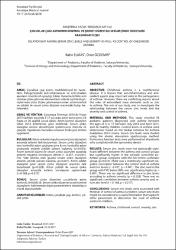ÇOCUKLUK ÇAĞI ASTIMININ KONTROL VE ŞİDDET DÜZEYİ İLE SERUM ÇİNKO DÜZEYLERİ ARASINDAKİ İLİŞKİ
Özet
AMAÇ: Çocukluk çağı astımı multifaktöriyel bir hastalıktır. Patogenezinde anti-inflamatuvar ve anti-oksidan ajanların önemli rol oynadığı bilinir. Bununla birlikte anti oksidan çinko gibi eser elementlerin rolü ile ilgili farklı görüşler mevcuttur. Bizim çalışmamızın amacı astım kontrol ve şiddeti ile serum çinko düzyleri arasındaki ilişkiyi belirlemekti. GEREÇ VE YÖNTEM: Çalışmaya Temmuz 2014 ile Nisan 2015 tarihleri arasında 3-17 yaş arası astım tanısı almış 56 hasta ve 26 sağlıklı çocuk alındı. Astım kontrol düzeyleri GINA 2014 kriterlerine göre belirlendi. Serum çinko düzeyleri atomic absorbsiyon spektroskopi metodu ile çalışıldı. Yapılabilen hastalara solunum fonksiyon testleri uygulandı. BULGULAR: Astım ve kontrol grubu serum çinko düzeyleri arasında anlamlı fark bulunmadı. Serum çinko düzeyleri tam kontrollü astım grubuna göre kısmi kontrollü astım grubunda anlamlı şekilde yüksek bulundu (p=0.023). Astım kontrol düzeyi ile serum çinko düzeyleri arasında anlamlı negative korelasyon izlendi (r: -0.437, p=0.001). FVC %80 altında olan grupta serum çinko düzeyleri anlamlı şekilde yüksek bulundu (p=0.001). Astım şiddet düzeyine göre serum çinko düzeyleri arasında fark bulunmadı (p=0.228). Astım şiddeti ile serum çinko düzeyleri arasında anlamlı korelasyon saptanmadı (r=0.168, p=0.217). SONUÇ: Serum çinko düzeyleri çocuklarda astım kontrolü ile ilişkili idi. Serum çinko düzeyleri astım kontrol düzeylerini belirlemede diğer parametrelere destekleyici olarak düşünülebilir. OBJECTIVE: Childhood asthma is a multifactorial disease. It is known that anti-inflammatory and antioxidant agents play important roles in the pathogenesis of asthma. However, there are conflicting reports about the roles of antioxidant trace elements such as zinc in asthma. The aim of our study was to investigate the relationship between the serum zinc levels and the severity and control of asthma. MATERIAL AND METHODS: This study enrolled 56 pediatric patients diagnosed with asthma between the ages of 3 to 17 between July 2014 and April 2015, and 26 healthy children. Control levels of asthma were determined based on the Global Initiative for Asthma Guidelines 2014 criteria. Serum zinc levels were studied using the atomic absorption spectroscopy method. Pulmonary function tests were performed on all patients who complied with the spirometry device. RESULTS: Serum zinc levels were not statistically significant different between the asthma and control groups but significantly higher in the partially controlled asthmatic group compared with the full control asthmatic group (p=0.023). There was a statistically significant negative correlation between the control level of asthma and zinc levels (r: -0.437, p = 0.001). The zinc level in the group with FVC below 80% was significantly higher (p = 0.001). There was no significant difference in zinc levels according to asthma severity (p = 0.228). There was no significant correlation between asthma severity and serum zinc level (r = 0.168, p = 0.217). CONCLUSIONS: Serum zinc levels were associated with the level of control of astma in children. Serum zinc levels might be considered as a useful biomarker that supports other parameters to determine the level of asthma control in children.
















